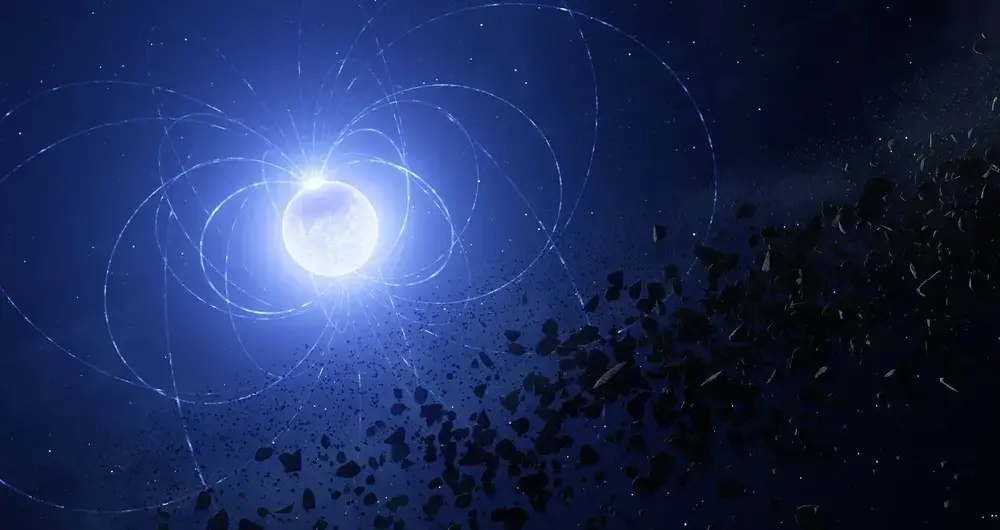A “metallic scar” was discovered on the surface of a dwarf star
- February 27, 2024
- 0
When a star like our Sun reaches the end of its life, it can swallow surrounding planets and asteroids that were born with it. Now, researchers using the
When a star like our Sun reaches the end of its life, it can swallow surrounding planets and asteroids that were born with it. Now, researchers using the

When a star like our Sun reaches the end of its life, it can swallow surrounding planets and asteroids that were born with it. Now, researchers using the European Southern Observatory’s Very Large Telescope (ESO’s VLT) in Chile have found for the first time a unique signature of this process, a scar imprinted on the surface of a white dwarf star. Results are published on: Astrophysics Journal Letters.
“It is well known that some white dwarfs (slowly cooling embers of stars like our Sun) engulf parts of planetary systems. We have now discovered that the star’s magnetic field plays an important role in this process, causing a scar to form on the planet’s surface. The surface of a white dwarf,” said Stefano Bagnulo, an astronomer at the Armagh Observatory and Planetarium in Northern Ireland, United Kingdom, and lead author of the study.
The scar the team observed is a concentration of metal imprinted on the surface of white dwarf WD 0816-310, the remnant of an Earth-sized star similar to but slightly larger than our Sun.
“We showed that these metals came from a fragment of a planet about 500 kilometers in diameter and the size of or possibly larger than Vesta, the second largest asteroid in the Solar System,” says Jay Farihi, a professor at the university. College of London.. from Great Britain and co-author of the study.
The observations also provided clues about how the star gets its metallic signature. The team noticed that the metal detection power changed as the star rotated; This suggested that the metals were concentrated in a specific region rather than being spread evenly on the surface of the white dwarf.
They also found that these changes are synchronized with changes in the white dwarf’s magnetic field; This shows that this metallic trace is located at one of the magnetic poles. Taken together, these clues suggest that the magnetic field directs metal towards the star, creating a scar. Previously, astronomers had observed numerous white dwarfs contaminated with metals scattered across the star’s surface. They are known to come from destroyed planets or asteroids that pass very close to the star, moving in orbits similar to those of comets in our solar system.
However, the team is confident that the evaporated material for WD 0816-310 was ionized by the white dwarf’s magnetic field and dragged to the magnetic poles. This process is similar to the formation of auroras on Earth and Jupiter.
“Surprisingly, the material was not evenly mixed on the star’s surface as predicted in theory. Instead, this scar is a concentrated field of planetary material held in place by the same magnetic field that directs the falling pieces,” says the co-author, a professor at Canada’s Western University in Armagh. author John Landstreet Observatory and Planetarium. “Nothing like this has been seen before.”
To reach these results, the team used a Swiss Army Knife instrument called FORS2 on the VLT, which allowed them to detect the metallic scar and connect it to the star’s magnetic field.
“ESO has a unique combination of capabilities needed to observe faint objects such as white dwarfs and precisely measure the magnetic fields of stars,” says Bagnulo. The team also used archival data from VLT’s X-shooter to support their findings.
Using the power of such observations, astronomers can explore the fundamental composition of exoplanets, which are planets orbiting other stars outside the solar system. This unique study also shows how planetary systems can remain dynamically active even after ‘death’.
Source: Port Altele
As an experienced journalist and author, Mary has been reporting on the latest news and trends for over 5 years. With a passion for uncovering the stories behind the headlines, Mary has earned a reputation as a trusted voice in the world of journalism. Her writing style is insightful, engaging and thought-provoking, as she takes a deep dive into the most pressing issues of our time.